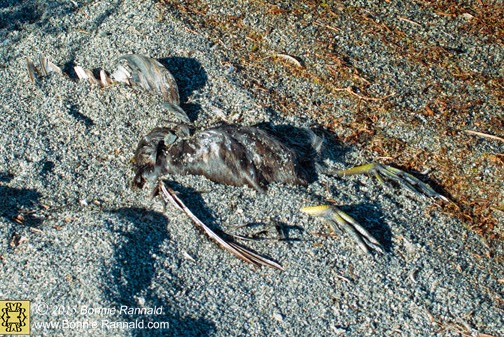Walker Lake's Water fowl in peril
Walker Lake, which should stand as a showcase for Nevada has certainly seen much
adversity over the years. The once thriving, natural high desert lake provided
the Agaicutta People (Paiute for Cutthroat Trout) with food sources that were
much more varied and higher in nutrition that our modern diets. Fish,
wildlife, water fowl and vegetation were plentiful and life was good. Once the
settlers started moving in, the Walker River, the main source of water that
feeds Walker Lake, was diverted for agriculture usage. Today, the Walker River
is at least 130% over allocated. As a result, not enough fresh water enters
Walker Lake, which has caused the level to drop and the salinity to increase.
Presently, due to the high salt level, the lake is no longer able to support
native fish.
Walker Lake's origin dates back to the Pleistocene epoch, (Ice Age) when Lake Lahontan covered most of what is now the Great Basin Desert. As the land dried and the climate warmed, Lake Lahontan began to recede, leaving a number of isolated lakes in closed basins, including Walker Lake.
Not too long ago, Walker Lake was a thriving source of water out in the desert. It was known for the Lahontan Cutthroat Trout which could grow to 40 pounds in size. Walker Lake was also a major stop-over for migratory birds. Located on the Pacific Flyway, the north-south travel route for American migratory birds, the water and shores provided essential food sources for the birds to rest and refuel.
Walker Lake's origin dates back to the Pleistocene epoch, (Ice Age) when Lake Lahontan covered most of what is now the Great Basin Desert. As the land dried and the climate warmed, Lake Lahontan began to recede, leaving a number of isolated lakes in closed basins, including Walker Lake.
Not too long ago, Walker Lake was a thriving source of water out in the desert. It was known for the Lahontan Cutthroat Trout which could grow to 40 pounds in size. Walker Lake was also a major stop-over for migratory birds. Located on the Pacific Flyway, the north-south travel route for American migratory birds, the water and shores provided essential food sources for the birds to rest and refuel.
Since the salty lake can no longer support the native fish, many of the seasonal visitors like the Common Loons that used to number in the hundreds no longer stop over at the lake. However a large number of shore birds still make Walker Lake their home, including the California Gull, American Coot, Long billed crulew and even the salt-loving Phalaropes.
The latest adversity to hit Walker Lake is an outbreak of Avian cholera that could put the remaining shore birds in great peril.
A number of dead birds have been
spotted along the shore at Walker Lake.
Most of the birds appear to be American
Coots.
There was one Mallard that appeared to have washed up on the
shore.
Avian cholera is a disease of fowl, which has crossed over from wild birds to become most prevalent in waterfowl. The disease is found in wetland areas all across the globe and even North America. Most of the outbreaks occur during the cold, wet weather of winter.
The bodies of several American Coots are caught in the tumbleweeds that line the shore.
Unfortunately once the disease is transmitted, it is almost impossible to contain. The area becomes contaminated with body secretions from diseased birds, which can remain in the water for several weeks. It is spread by direct contact to birds that are showing various symptoms including mucous draining from the mouth, nasal discharge and blood stained diarrhea.
The bacteria is ingested from
contaminated food and even spread by birds scavenging on infected carcasses.
Avian cholera is a horrible disease and has been know to kill so quickly that birds literally die while flying and fall from the sky.

Infected
birds may suffer convulsions, disorientation where they swim in circles, throw
their heads around violently and even fly upside down.
The only means of containment is prompt removal and proper disposal of the dead carcasses. I am very concerned at this time how long these birds have been lying dead and how many other birds have become diseased. Time will surely tell and I do hope with all my being that Walker Lake will not suffer another major loss in its beauty of all the remaining birds the grace her beautiful skies.
http://bonnierannald.blogspot.com/2012/02/inland-gulls-of-walker-lake-nevada.html
http://bonnierannald.blogspot.com/2012/08/walker-lake-water-fowl.html
http://www.walkerlakenv.org/articles%204.htm
http://www.nwhc.usgs.gov/disease_information/avian_cholera/
What
an exciting and interesting photo-adventure this day has been. I love
it when I am drawn to an area and not knowing what to expect I get
treated to new experiences.
Sign up and follow my blog to see where my next photo-adventure will be!
Photography places me in the moment where I can share that moment in time. It becomes a life story as represented by my interaction with the scene. The happiness and beauty or the sorrow and strife; how I focus leaves a lasting impression that might touch the viewer on a spiritual level.
"Reflecting Nature's Artistry"
No images on this blog are within Public Domain or are available for free download.
All rights reserved, world-wide and images protected by Digital
Millennium Copyright Act (DMCA). All photography, graphics, text,
design, and content is copyrighted by Bonnie Rannald and should not be
copied, down-loaded, transferred and re-created in any way without the
express consent, in writing to Bonnie Rannald.
For information on Bonnie Rannald licensed, right-managed images, please
submit a written request.












No comments:
Post a Comment
I welcome your response or feedback to this post. Please leave your comment below and share my Photo-Adventures with your family and friends. Subscribe to my blog and follow me on Facebook.